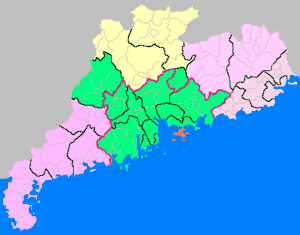Kaiping
Kaiping (Chinese: 开平), alternately romanized in Cantonese as Hoiping,[lower-alpha 1] is a county-level city in Guangdong Province, China. It is located west of the Pearl River Delta and administered as part of the prefecture-level city of Jiangmen. The surrounding area, especially Sze Yup (Chinese: 四邑), is the ancestral homeland of many overseas Chinese, particularly in the United States.[2] Kaiping has a population of 688,242 as of 2017 and an area of 1,659 square kilometres (641 sq mi).[3] The locals speak a variant of the Toishan (Hoisan) dialect.
Kaiping 开平市 Hoiping | |
|---|---|
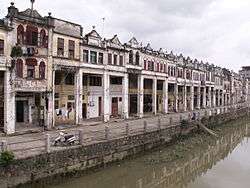 Dixi Road in Chikan, Kaiping | |
.png) Location of Kaiping City (red) in Kaiping (pink), Guangdong province, and the PRC | |
 Kaiping Location of the city centre in Guangdong | |
| Coordinates: 22°22′38″N 112°41′54″E | |
| Country | People's Republic of China |
| Province | Guangdong |
| Prefecture-level city | Jiangmen |
| County seat | Changsha Subdistrict (长沙街道) |
| Area | |
| • Total | 1,659 km2 (641 sq mi) |
| Population (2017 census) | |
| • Total | 688,242 |
| • Density | 410/km2 (1,100/sq mi) |
| Time zone | UTC+8 (China Standard) |
| Postal code | 529300 |
| Area code(s) | 0750 |
| Website | www |
| Kaiping | |||||||||||||||||||||
|---|---|---|---|---|---|---|---|---|---|---|---|---|---|---|---|---|---|---|---|---|---|
| Simplified Chinese | 开平 | ||||||||||||||||||||
| Traditional Chinese | 開平 | ||||||||||||||||||||
| Taishanese | Hoi3-pen6 (local) | ||||||||||||||||||||
| Hanyu Pinyin | Kāipíng | ||||||||||||||||||||
| Postal | Hoiping | ||||||||||||||||||||
| |||||||||||||||||||||
History
During the Northern Song dynasty, Kaiping was under the administration of Xin'an county (信安縣)[4] Under the Qing (1649), Kaiping County made up part of the commandery of Zhaoqing.[1] It was promoted to county-level city status in 1993.
Administration
Administratively, Kaiping is administered as part of the prefecture-level city of Jiangmen.
| Name | Chinese (S) | Hanyu Pinyin | Population (2010)[5] |
|---|---|---|---|
| Sanbu Subdistrict | 三埠街道 | Sānbù Jiēdào | 173,100 |
| Changsha Subdistrict | 长沙街道 | Chángshā Jiēdào | 124,829 |
| Shatang town | 沙塘镇 | Shātáng Zhèn | 24,667 |
| Chacheng town | 苍城镇 | Cāngchéng Zhèn | 26,750 |
| Longsheng town | 龙胜镇 | Lóngshèng Zhèn | 26,161 |
| Dasha town | 大沙镇 | Dàshā Zhèn | 22,298 |
| Magang town | 马冈镇 | Mǎgāng Zhèn | 30,728 |
| Tangkou town | 塘口镇 | Tángkǒu Zhèn | 22,626 |
| Chikan town | 赤坎镇 | Chìkǎn Zhèn | 37,260 |
| Baihe town | 百合镇 | Bǎihé Zhèn | 17,621 |
| Xiangang town | 蚬冈镇 | Xiǎngāng Zhèn | 13,280 |
| Jinji town | 金鸡镇 | Jīnjī Zhèn | 16,493 |
| Yueshan town | 月山镇 | Yuèshān Zhèn | 46,700 |
| Chishui town | 赤水镇 | Chìshuǐ Zhèn | 25,894 |
| Shuikou town | 水口镇 | Shuǐkǒu Zhèn | 90,835 |
Geography
Kaiping city centre is located on the Tanjiang River, 140 kilometres (87 mi) away from Guangzhou, on the edge of the county Kaiping west of the Pearl River Delta. Kaiping consists of broken terrain, mostly either rocky or swampy, with only a third of the land arable.[2] The county is shaped like a giant question mark (see map, in pink) and includes rural areas as well as three port cities: Changsha, Xinchang, and Dihai.
Notable people:
- Li, Jiang(李江) : a poet of Ming dynasty
- Szeto Wah(司徒華): Hong Kong politician
- Szutu, Daid Sing(司徒達盛) - freelancer of Kwangtung cultural Quarterly ( < 廣東文獻》季刊)
- Lee, Kwok wai (利國偉): former Hong Kong banker
Sights
Kaiping Diaolou
Kaiping Diaolous (碉楼) are fortified multi-storey towers constructed in the village countryside of mainly the Kaiping area. They were built from the early Qing Dynasty to the early 20th century, reaching a peak in the 1920s and 1930s, with the financial aid of overseas Chinese, when there were more than three thousand of these structures. Today, approximately 1,800 diaolou are still standing, with the most in the towns of Tangkou (塘口镇), Baihe (百合镇), Chikan (赤坎镇), and Xiangang (蚬冈镇), in that order (see map in article by Batto).[6]
In the late 19th and early 20th century, Kaiping was a region of major emigration abroad, and a melting pot of ideas and trends brought back by overseas Chinese, Huaqiao, made good.[2] As a consequence, many watchtowers incorporated architectural features from China and the West. These were examples of the Qiaoxiang (僑鄉) architecture.[7] The diaolou were built by villagers during a time of chaos and served two purposes: housing and protecting against forays by bandits.[6]
In 2007, the Kaiping diaolou and villages were added to the list of UNESCO World Heritage Sites and consist of four separate restored village areas: Zilicun village (自力村) in Tangkou, Sanmenli village (三门里) in Chikan, Jinjiangli village (锦江里) in Xiangang, and Majianglong village cluster (马降龙村落群) in Baihe township.[8]
The Kaiping diaolou was the location for parts of the filming of 2010 movie Let the Bullets Fly (让子弹飞).[9]
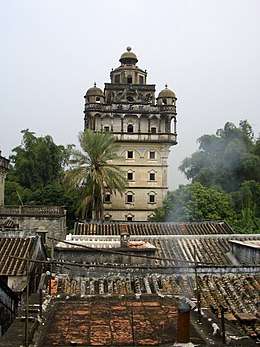 Ruishi Lou in Jinjiangli
Ruishi Lou in Jinjiangli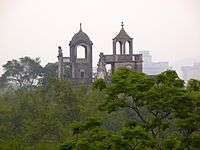 Majianglong Diaolou
Majianglong Diaolou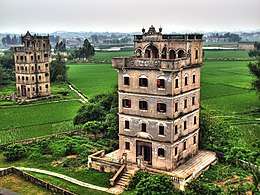 Diaolou cluster at Zilicun
Diaolou cluster at Zilicun- Nan Lou in Chikan
Examples of diaolous include:
- Yinglonglou (迎龙楼), oldest extant diaolou in Kaiping, in the village of Sanmenli (Chikan township) built by the Guan (关族) lineage during the Jiajing era of the Ming dynasty (1522-1566), is a massive three-storey fortress with one-meter thick walls, in contrast with the high tower diaolou built much later with the aid of Huaqiao.[6]
- Jinjiangli Diaolou Cluster (锦江里雕楼群), situated behind Jinjiangli Village (Xiangang Township), includes three exquisite diaolous: Ruishi Lou, Shengfeng Lou, and Jinjiang Lou. Ruishi Diaolou, constructed in 1921, has nine floors and is the tallest diaolou in Kaiping. It features a Byzantine style roof and a Roman dome.
- The Majianglong diaolou cluster (马降龙雕楼群) is spread across five villages (Baihe township) in a bamboo forest: Yong'an and Nan'an Villages of the Huang (黄) family; Hedong, Qinglin, and Longjiang Villages of the Guan (关) family.
- Zilicun Diaolou Cluster (自力村雕楼群), located in Zilicun Village (Tangkou township), includes nine diaolous, the largest number among the four Kaiping villages designated by UNESCO. They feature the fusion of Chinese and various Western architectural styles and rise up surrealistically over the rice paddy fields.
- Fangshi Denglou - Built in 1920 after contributions from villagers, this denglou is five storeys high. It is referred to as the "Light Tower" because it had an enormous searchlight as bright as the beam of a lighthouse.
- Li Garden, in Beiyi Xiang, was constructed in 1936 by Mr. Xie Weili, a Chinese emigrant to the United States.
- Bianchouzhu Lou (The Leaning Tower), located in Nanxing Village was constructed in 1903. It has seven floors.
- Nan Lou (南楼), or the "Southern Diaolou", located on the riverbank in Chikan township, which was known for seven local soldiers by the surname Situ (司徒) who died defending Chikan from the Japanese.
Chikan
Chikan (赤坎) is officially designated as a National Historic and Cultural Town of China (中国历史文化名镇). The old town of Chikan has many historical sites that are about one hundred years old. For example, it has over 600 late-Qing and early-Republic historic Tong laus or Qilous (唐樓/ 騎樓) continuous, spanning over a length of 3 kilometers, including the riverside stretch along Dixi Lu (堤西路), sometimes referred to as 'European Styled Street'. Part of old Chikan town has been designated Chikan Studio City (赤坎影视城) for filming of historical scenes.
Chikan township also has two restored diaolous: Yinglonglou, built by the Guan (关族) lineage in the Ming dynasty, and Nanlou, memorialized by the martyrdom of seven Situ clan (司徒族) members in the early 20th century.
Historically, Chikan has been shaped by these two competing clans.[2] One example is the existence of two libraries: the Situ's library, opened in 1926, and, not to be outdone, the Guan's library, opened in 1931; both libraries funded by overseas Chinese and incorporated architecture features from overseas.
It is a famous and well-known location for braised pork in noodles to locals.
Chikan is to become a tourist destination and the closing of local stores, dining posts, and streets are scheduled for the summer of 2017.[10]
Miscellaneous
Kaiping has been twinned with Mesa, Arizona, United States, since October 18, 1993.
Kaiping was a major source of emigrants at the turn of the 20th century. As a result, a large number of early Chinese Canadian and Chinese American communities had people who originated from Kaiping and its neighboring counties of Taishan, Enping and Xinhui, which is known collectively as Sze Yup. It is said that there are more Kaipingnese people living abroad today than there are Kaipingnese in Kaiping. In a 2016 report, Deloitte estimated that there are 750,000 Kaiping-born overseas Chinese.[11]
In 1973, various people originated from Kaiping started the Hoi Ping Chamber of Commerce Secondary School in Hong Kong.
Climate
| Climate data for Kaiping (1981−2010) | |||||||||||||
|---|---|---|---|---|---|---|---|---|---|---|---|---|---|
| Month | Jan | Feb | Mar | Apr | May | Jun | Jul | Aug | Sep | Oct | Nov | Dec | Year |
| Record high °C (°F) | 28.5 (83.3) |
29.3 (84.7) |
31.7 (89.1) |
33.8 (92.8) |
35.2 (95.4) |
38.0 (100.4) |
39.4 (102.9) |
37.8 (100.0) |
36.0 (96.8) |
35.8 (96.4) |
33.3 (91.9) |
29.3 (84.7) |
39.4 (102.9) |
| Average high °C (°F) | 19.0 (66.2) |
20.1 (68.2) |
22.5 (72.5) |
26.9 (80.4) |
30.2 (86.4) |
31.7 (89.1) |
32.8 (91.0) |
32.7 (90.9) |
31.3 (88.3) |
29.1 (84.4) |
25.3 (77.5) |
21.0 (69.8) |
26.9 (80.4) |
| Daily mean °C (°F) | 15.0 (59.0) |
16.2 (61.2) |
18.9 (66.0) |
23.4 (74.1) |
26.5 (79.7) |
28.1 (82.6) |
28.9 (84.0) |
28.7 (83.7) |
27.6 (81.7) |
25.1 (77.2) |
21.1 (70.0) |
16.9 (62.4) |
23.0 (73.5) |
| Average low °C (°F) | 12.1 (53.8) |
13.6 (56.5) |
16.4 (61.5) |
20.9 (69.6) |
23.9 (75.0) |
25.6 (78.1) |
26.2 (79.2) |
26.1 (79.0) |
24.8 (76.6) |
22.1 (71.8) |
17.8 (64.0) |
13.7 (56.7) |
20.3 (68.5) |
| Record low °C (°F) | 3.3 (37.9) |
3.3 (37.9) |
6.9 (44.4) |
9.3 (48.7) |
17.3 (63.1) |
18.3 (64.9) |
22.6 (72.7) |
22.2 (72.0) |
16.9 (62.4) |
14.3 (57.7) |
8.9 (48.0) |
2.5 (36.5) |
2.5 (36.5) |
| Average precipitation mm (inches) | 36.4 (1.43) |
66.0 (2.60) |
66.6 (2.62) |
197.7 (7.78) |
267.5 (10.53) |
334.1 (13.15) |
269.5 (10.61) |
294.4 (11.59) |
195.3 (7.69) |
72.0 (2.83) |
41.3 (1.63) |
29.7 (1.17) |
1,870.5 (73.63) |
| Average relative humidity (%) | 71 | 77 | 81 | 82 | 80 | 83 | 80 | 81 | 76 | 69 | 65 | 65 | 76 |
| Source: China Meteorological Data Service Center | |||||||||||||
Notes
- The Postal Map romanization is based on the local Cantonese pronunciation. Other romanizations include Kae Ping.[1]
References
Citations
- Bolton & al. (1941), p. 262.
- Woon, Yuen-fong (1984). Social organization in South China, 1911-1949: the case of the Kuan lineage in K'ai-p'ing county. Ann Arbor, MI: Center for Chinese Studies, University of Michigan. ISBN 0-89264-051-0.
- "Profile of Kaiping" (in Chinese). Archived from the original on January 18, 2010. Retrieved 2008-07-12.
- 《 廣東省廣州市佛山地區韶關地區沿革地理》 [Administration alteration of Guangzhou, Foshan and Shaoguan]
- Census Office of the State Council of the People's Republic of China; Population and Employment Statistics Division of the National Bureau of Statistics of the People's Republic of China (2012). 中国2010人口普查分乡、镇、街道资料 (1 ed.). Beijing: China Statistics Print. ISBN 978-7-5037-6660-2.
- Batto, Patricia R.S. (July–August 2006). "The Diaolou of Kaiping (1842-1937): Buildings for dangerous times". China Perspectives. Translated by Hall, Jonathan. Retrieved 25 May 2017.
...the diaolou were built in the countryside, in villages and on the initiative of the peasants themselves. Contrary to normal expectations, thanks to emigration we can see a certain “cosmopolitanism” among the peasants in Kaiping... the diaolou are the epitome of overseas Chinese culture, embodied in stone.
- Pan, Lynn (1999). The Encyclopedia of the Chinese Overseas. Cambridge, MA: Harvard University Press. pp. 28–29. ISBN 0674252101.
- "Kaiping Diaolou and Villages" (PDF). UNESCO World Heritage Convention. 2007. Retrieved 25 May 2017.
- "Kaiping "Diaolou" - Location of "Let the Bullets Fly"". CRI english. December 2010. Retrieved 27 May 2017.
- "Families who've lived in old Chinese town for generations being kicked out to make way for tourists". south china morning post. 28 August 2017. Retrieved 4 October 2017.
- Deloitte 德勤 (2016). "Research Report on Investment Environment Kaiping, Guangdong" (PDF). deloitte.com.
4. < 廣東省廣州市佛山地區韶關地區沿革地理》( history and geographical cha es of Guangzhou region, foshan region and shaoguan region )
Bibliography
- Bolton, Kingsley; et al. (1941), Triad Societies, Vol. 5, Abingdon: Routledge, reprinted 2000.
Guangdong Zheng Guangzhou shi fishan di qu shaoguan di qu yuan he di Li ( history of geographical alterations of Guangzhou, Foshan and Shaoguan (廣東省廣州市佛山地區韶關地區沿革地理》) Author: Zhu, peng Xur Lin publishing limited 1984
External links
| Wikimedia Commons has media related to Kaiping. |
| Wikivoyage has a travel guide for Kaiping. |
